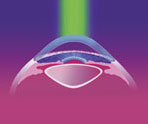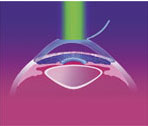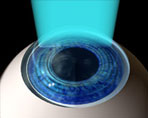Advanced Surface Ablation (ASA)
 Advanced Surface Ablation is a relatively new laser vision procedure that has additional safety features over LASIK making it an ideal alternative for some patients. Instead of cutting a flap on the front of the cornea, the surface skin cells (epithelium) are loosened with a diluted alcohol. The corneal surface is then treated with the laser and covered with a bandage contact lens.
Advanced Surface Ablation is a relatively new laser vision procedure that has additional safety features over LASIK making it an ideal alternative for some patients. Instead of cutting a flap on the front of the cornea, the surface skin cells (epithelium) are loosened with a diluted alcohol. The corneal surface is then treated with the laser and covered with a bandage contact lens.
 The margin of safety with ASA may be greater than that with LASIK as the need for a microkeratome is eliminated, so there's no risk of flap complications. You do not need to worry about rubbing your eye or bumping it after surgery and having the LASIK flap slip or wrinkle, because there is no flap. The nerve endings that control tear secretion are not cut, so there is less of a problem with dry eye after surgery.
The margin of safety with ASA may be greater than that with LASIK as the need for a microkeratome is eliminated, so there's no risk of flap complications. You do not need to worry about rubbing your eye or bumping it after surgery and having the LASIK flap slip or wrinkle, because there is no flap. The nerve endings that control tear secretion are not cut, so there is less of a problem with dry eye after surgery.
ASA removes tissue within the cornea to treat low to high levels of myopia, hyperopia and astigmatism.
 To treat myopia, the steep cornea is made flatter by removing tissue from the center of the cornea. This moves the point of focus from in front of the retina to directly on the retina.
To treat myopia, the steep cornea is made flatter by removing tissue from the center of the cornea. This moves the point of focus from in front of the retina to directly on the retina.
 To treat hyperopia, the flat cornea is made steeper by removing tissue outside of the central optical zone of the cornea. This moves the point of focus from behind the retina to directly on the retina.
To treat hyperopia, the flat cornea is made steeper by removing tissue outside of the central optical zone of the cornea. This moves the point of focus from behind the retina to directly on the retina.
 To treat astigmatism, the cornea is made more spherical -- like a basketball instead of a football. This eliminates multiple focusing points within the eye and creates one point of focus on the retina. Astigmatism can be treated at the same time as nearsightedness and farsightedness.
To treat astigmatism, the cornea is made more spherical -- like a basketball instead of a football. This eliminates multiple focusing points within the eye and creates one point of focus on the retina. Astigmatism can be treated at the same time as nearsightedness and farsightedness.
ASA is a better choice for those who:
- Want to reduce or eliminate their dependence on glasses or contacts.
- Are over 18 years of age.
- Have had a stable eye prescription for at least one year.
- Have no health issues affecting their eyes.
- Have wide pupils.
- Have corneas too thin for LASIK.
- Want to avoid LASIK flap complications.
- Want to minimize dry eye problems after surgery.
- Can not have LASIK because of eye pressure problems (glaucoma) who cannot have LASIK because of corneal dystrophy problems.
- Do not want LASIK because it requires a microkeratome.
Results:
 In patients with myopia up to moderate ranges, both ASA and LASIK have shown comparably excellent visual results. There are various terms for surface treatment that have been employed since the inception of laser vision correction (Flapless Lasik, variously been called PRK, LASEK, epi-LASIK, Trans-Epithelial Surface treatment). All of these techniques use the excimer laser to perform the optical sculpting in exactly the same fashion.
In patients with myopia up to moderate ranges, both ASA and LASIK have shown comparably excellent visual results. There are various terms for surface treatment that have been employed since the inception of laser vision correction (Flapless Lasik, variously been called PRK, LASEK, epi-LASIK, Trans-Epithelial Surface treatment). All of these techniques use the excimer laser to perform the optical sculpting in exactly the same fashion.
When you do the Pre Lasik Workup, all relevant factors are measured, and taken into consideration as a part of determining your candidacy for vision correction. Dr. Mneimneh will explain to you the testing performed at your initial evaluation, and advise the better choice for you, either Lasik or ASA.